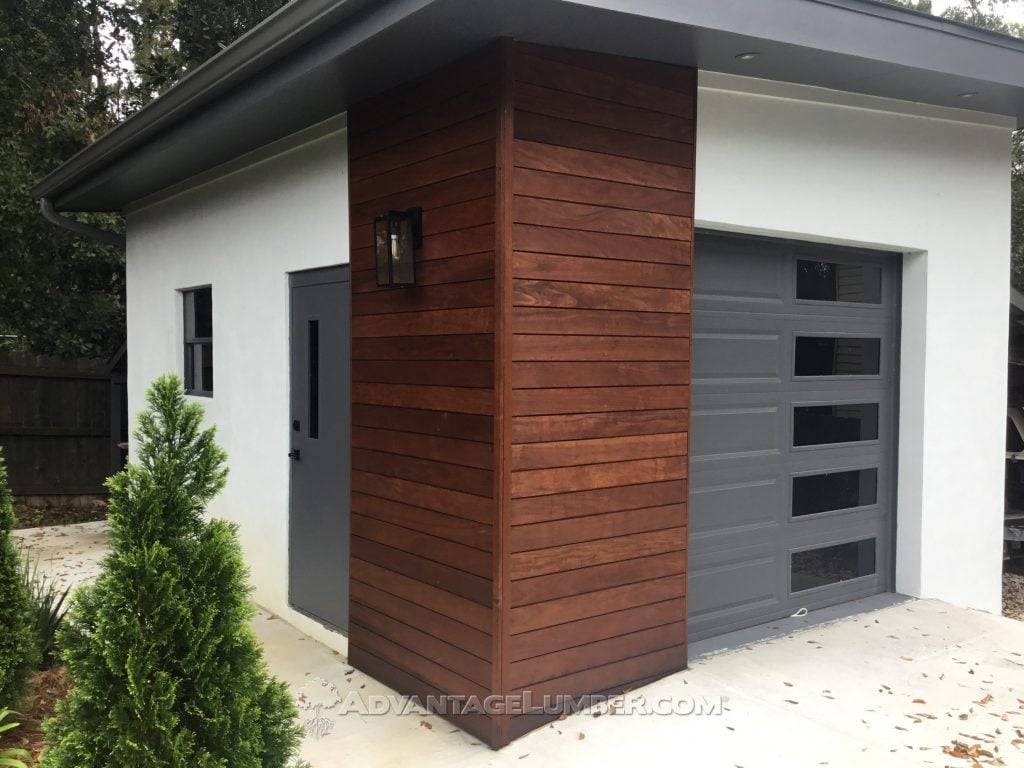Shiplap siding is a type of siding typically made from solid wood featuring a rabbet joint or groove on either side of each board. When installed, the boards slightly overlap, creating a distinct visual effect with evenly spaced horizontal seams. It’s often used both on the exterior of buildings and indoors for a rustic or farmhouse aesthetic.
Here are the key components of shiplap siding:
- Materials: Shiplap is traditionally made of wood, but modern variations can be found in other materials, such as PVC or fiber cement. However, wood remains the most popular choice due to its natural and warm appearance.
- Design: Each shiplap board is milled with a halved groove called a rabbet along the top and bottom opposing edges. The rabbet allows the boards to overlap slightly while lying flush against the wall, creating a tight seal that helps to protect against weather.
- Installation: Shiplap boards are installed horizontally, with the top board overlapping the one below. This overlapping design helps to channel away water in exterior applications, making shiplap a popular choice for areas with heavy rainfall.
- Aesthetics: Shiplap’s unique design creates a series of horizontal lines where the boards meet. This feature can add depth and visual interest to a wall, and it’s one of the reasons why shiplap is so popular for interior design.
Shiplap Siding Benefits
- Water Resistance: The primary way shiplap siding protects your home is through its unique design. Each board is milled to have a groove along the top and bottom edges. When installed, these boards overlap, creating a tight seal. This design promotes the run-off of rain and melting snow, helping to prevent water from penetrating the siding and reaching the underlying wall structure.
- Wind Protection: The tight fit and overlap of shiplap boards also create an effective barrier against wind. This can help to prevent drafts from infiltrating your home, increasing its overall energy efficiency.
- Thermal Insulation: As part of the outer envelope of a building, any kind of siding adds an extra layer of thermal insulation. Shiplap siding, being a solid and relatively thick material, can help to keep your home warmer in the winter and cooler in the summer.
- UV Protection: If properly treated with paint or a UV-protective sealant, shiplap siding can shield the underlying structure of your home from harmful ultraviolet (UV) rays, which can cause damage over time.
- Durability: Shiplap is a durable material that can withstand many types of weather conditions. This durability means it can protect the structure of your home for many years before needing to be replaced.
- Pest Protection: The right type of shiplap wood siding can help protect your home from pests as certain woods like Ipe, Cumaru, Garapa, Massaranduba, Tigerwood and Teak are naturally resistant to wood boring insects. Additionally many of these woods are up to 3 times harder than oak which makes them incredibly tough for larger critter like squirrels and chipmunks that sometimes chew through homes.
Best Shiplap Wood Species
It’s important to note that the type of wood you choose can significantly influence these benefits. Let’s discuss the top wood choices for shiplap siding: Ipe, Cumaru, Garapa, Tigerwood, Massaranduba, Mahogany, and Teak.
1. Ipe: Ipe is a South American hardwood known for its exceptional durability and resistance to rot, decay, and insects. Its beautiful deep brown color, strength, and density make it a perfect choice for shiplap siding.
2. Cumaru: Also known as Brazilian Teak, Cumaru is another dense, durable hardwood. It is resistant to rot and decay, and its natural oils deter insects. Its color varies from reddish to golden brown.
3. Garapa: Garapa, also known as Brazilian Ash, is a light-yellow hardwood that’s resistant to decay, rot, and insect attack. It’s a bit softer than Ipe or Cumaru but still provides excellent durability.
4. Tigerwood: This is a durable hardwood with distinctive orange color and dark striping, hence the name. It’s naturally resistant to rot and decay.
5. Massaranduba: Known as Brazilian Redwood, Massaranduba is incredibly dense and strong. Its rich red-brown color provides an appealing aesthetic, and it’s also resistant to rot and insects.
6. Mahogany: Mahogany is a classic choice for its beauty and longevity. Its natural resistance to decay, insects, and adverse weather conditions makes it an excellent choice for shiplap siding.
7. Teak: This is one of the best woods for outdoor use. It has a high oil content, which makes it resistant to water, decay, and insects. Teak can withstand harsh weather conditions and ages gracefully.

Each of these woods offers its own unique set of benefits and aesthetic appeal. When choosing the right wood for your shiplap siding, consider your local climate, your home’s architectural style, and your personal preference for color and grain pattern. Proper installation and maintenance are also crucial to ensure the longevity and beauty of your shiplap siding.






